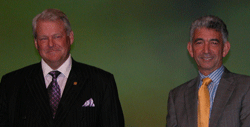Article
Dr. Lindstrom takes office as ASCRS president
The challenges and opportunities facing ophthalmologists were brought into focus as Samuel Masket, MD, outgoing president of the American Society of Cataract and Refractive Surgery (ASCRS), passed the torch to his successor, Richard L. Lindstrom, MD.

The challenges and opportunities facing ophthalmologists were brought into focus as Samuel Masket, MD (right), outgoing president of the American Society of Cataract and Refractive Surgery (ASCRS), passed the torch to his successor, Richard L. Lindstrom, MD (left).
Dr. Masket addressed the audience first with a review of ASCRS achievements during his term. In response to a major outbreak of postoperative toxic anterior segment syndrome (TASS), Dr. Masket initiated a new ASCRS task force to investigate. While the cause of the outbreak was never identified, the ASCRS task force-which included representatives from industry, the Centers for Disease Control and Prevention, and the Mayo Clinic-developed guidelines for the appropriate handling of disposable and reusable surgical goods. An epidemic of Fusarium corneal ulcers triggered Dr. Masket's launch of an infections disease task force to provide ASCRS with a rapid response mechanism to deal with problems of that nature.
ASCRS was instrumental in obtaining a ruling from the Center for Medicare and Medicaid Services (CMS) that allowed Medicare recipients to opt for premium priced toric IOLs.
Dr. Masket applauded the industry's continuing technology advancements, which benefits patients and practice revenues alike. He also praised the averted proposed 5.1% reduction in Medicare reimbursements slated for 2007, but cautioned that physicians still face reductions of 10% in 2008 and a total of nearly 40% through 2013.
"The general population . . . has an abysmal lack of understanding of presbyopia," Dr. Masket said. To help presbyopes understand surgical options for managing their vision, the Eye Surgery Education Council of the ASCRS Foundation formed committee to launch a broad-based presbyopia-education initiative.
"I have enjoyed the opportunity to serve and to help shape the future of ASCRS," Dr. Masket concluded. His vision of the future included new channels of communication, such as podcasts, and enhanced international relations.
As the 22nd ASCRS president, Dr. Lindstrom sees his post as a privilege and an honor. He related that 2007 marks his 30th year as an ASCRS member, although in 1977, the society was called the American Intraocular Implant Society.
"I've been a member of ASCRS for a long time," Dr. Lindstrom said. "I'm familiar with its strengths and opportunities and, more important, I am very committed to continuing its success."
The future, he said, is with young ophthalmologists.
Dr. Lindstrom vowed to uphold and advance the society's mission statement, the core of which is education. During his tenure the educational needs of ASCRS members will be met with "new meetings, new programs, and a rapidly expanding menu of electronic and Internet educational services."
While ASCRS currently has 9,500 members, Dr. Lindstrom said they key to the society's future is to "recruit, retain, and motivate a strong and involved membership." To that end, ASCRS has launched a Members First initiative-a yardstick for judging every activity of the society on its potential for enhancing members' well-being and growing the society. Part of growing ASCRS membership is to reach out to cataract and glaucoma specialists, as well as comprehensive ophthalmologists.
In the face of obstacles, such as sustainable growth rate, pay for performance, and reductions in Medicare reimbursements, Dr. Lindstrom made the case for collaborative political activism.
"I believe that ASCRS is the strongest advocate at the federal level for you and I, the ophthalmic surgeons," he concluded.
Newsletter
Don’t miss out—get Ophthalmology Times updates on the latest clinical advancements and expert interviews, straight to your inbox.




